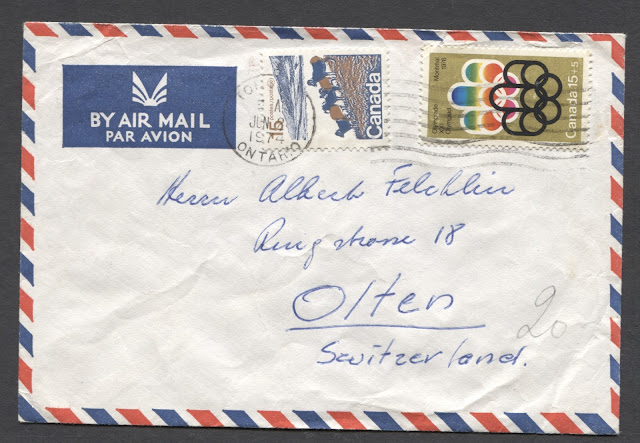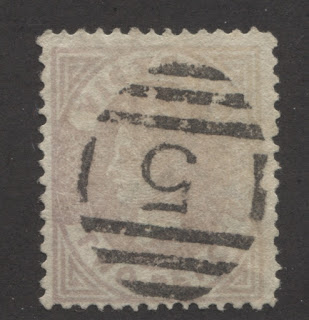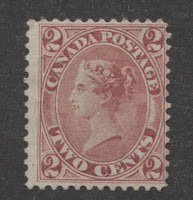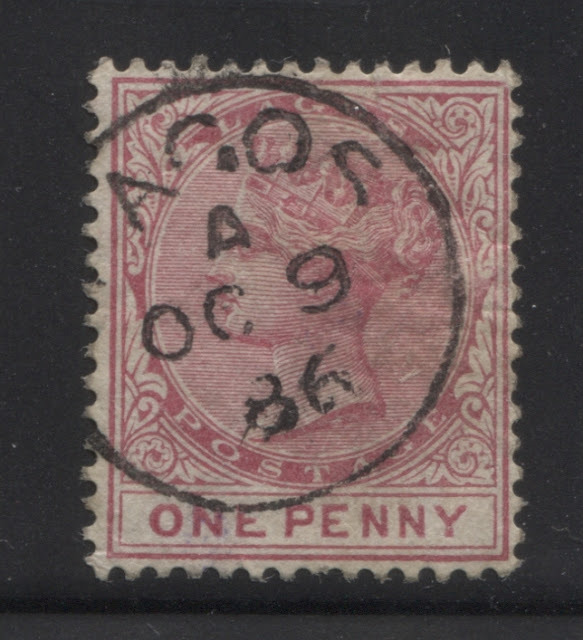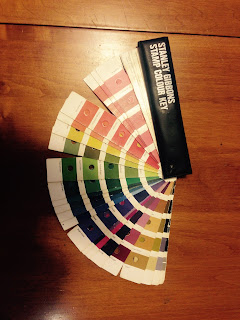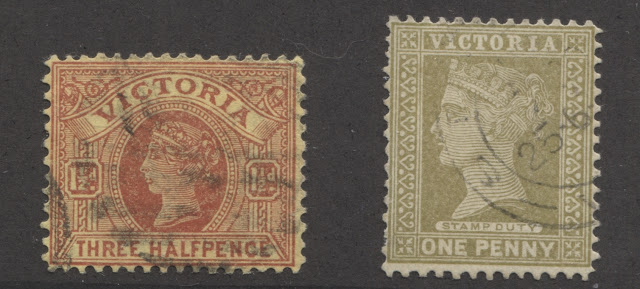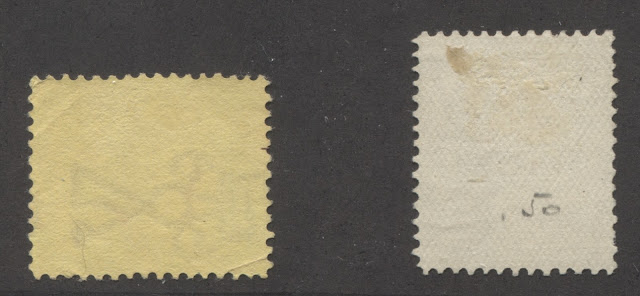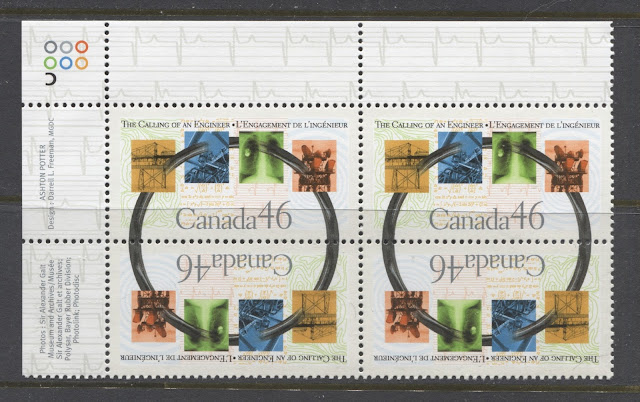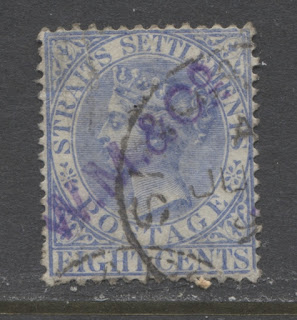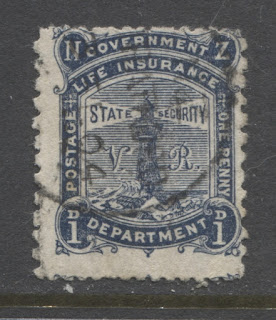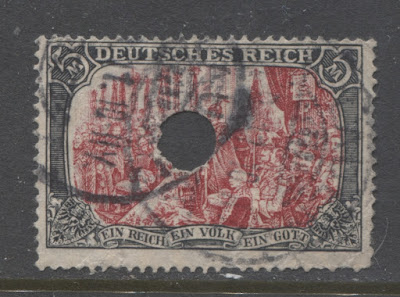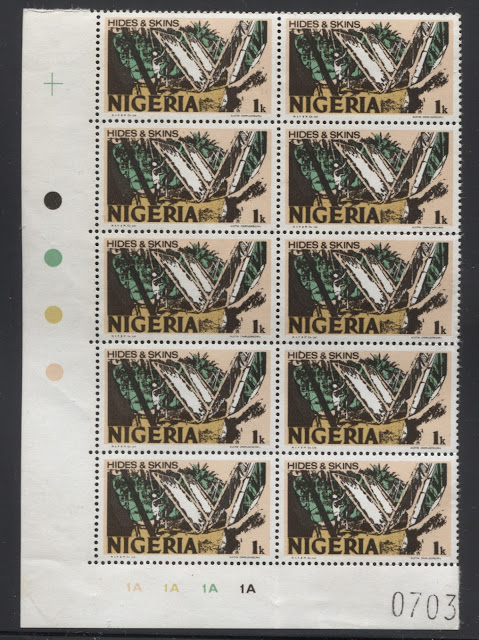Air Mail Cover
Philatelic Glossary - Terms Starting With "A" to "C"
An airmail cover is any cover that has been sent by airplane for at least a portion of its route, as opposed to travelling exclusively on land or at sea. Nowadays airmail is the standard method of travel for mail going outside the country of mailing, but up until the 1970's this was not the case in most countries. Up until this time, airmail was a premium service that cost more money to use and in the 1930's when it first introduced, it was very expensive, especially if you were sending to a very unusual destination.
Airmail items would generally either have a bilingual blue and white label attached that would read "By Air Mail Par Avion", or the envelope itself would be pre-printed with that label, as well as a blue and red striped border, such as on the cover shown above.
Aniline Ink

Aniline ink is a type of ink that contains a tar-based compound that causes it to be highly suffused into the paper on which it is printed. The colour will appear to be super saturated, and will appear to bleed through the paper of the stamp. It will be most apparent when the stamp is viewed from the back, as the ink will usually be visible through the gum, in a way that it is generally not visible on the stamps printed using normal ink. The stamp on the right is printed from an aniline blue, whereas the one on the left is printed from a standard violet blue ink, Note how much cleaner and sharper the printing of the left stamp is, compared to the stamp on the right, which looks somewhat fuzzy by comparison.
The picture below shows the difference when viewed from the back:

Here you can clearly see that there is no part of the design or ink visible through the gum of the left stamp. In contrast the right stamp, printed in the aniline ink shows the design clearly through the back of the stamp. This is the easiest way to identify it.
Generally aniline inks are nearly always much scarcer than the regular inks, and are usually not listed in any but the most specialized catalogues.
Bantam
The standard sized definitive stamp in the 19th century and through much of the last 177 years has measured approximately 3/4 inch wide (about 20 mm) by an inch tall. However, there was a very small handful of countries that issued very small stamps that were approximately half this size, or in some cases even smaller. These stamps are known to philatelists as "bantams". The above halfpenny stamp issued by Great Britain in 1870 is one of the earliest bantams that I am aware of, with the only earlier ones being the first stamps of Russia and Poland, which were issued in the 1860's. These earlier bantams were tall and narrow, being about an inch tall, by about a third of an inch wide.
Barred Grid Cancellation
A barred grid cancellation is one that consists of network of parallel lines, usually arranged in an oval or circular pattern. Such cancellations are often referred to as "killers" s their purpose was to thoroughly deface the stamps to which they were applied to prevent re-use. The grids could either consist of bars only, in which case they were known as "dumb" cancellations, or they could contain letters or numerals. The letters or numerals often corresponded to specific post offices, or regions, and as a result, the collecting of these cancellations is another highly specialized field in which some of the cancellations can be quite rare.
Collectors who study these cancellations generally consider the complete outside dimensions of the cancellation, as well as the thickness of the bars and the space between them.
Barred grid cancellations were produced either by wooden or steel hammers, as well as with corks tht had the grid carved into them.
Barred Numeral Cancellation
A barred numeral cancellation is any cancellation in which there is a numeral in the centre, which is surrounded by a pattern of bars, which is usually arranged in an oval pattern. These were very popular cancellations during the 19th century, and usually the numeral corresponds with a particular post office, which was assigned a specific number. Some of these can be exceptionally scarce and valuable, and the study of these has accordingly become very popular in many countries, with specialists publishing books in which they detail the history and rarity of these cancellations.
Bisect
Occasionally if the supply of a particular stamp ran out postmasters would improvise by taking a higher denomination and cutting it into halves, thirds or quarters. This was done in New Brunswick in the 1850's when there was a need for one and a half penny stamps. Sometimes a threepenny stamp would be cut in half diagonally to make a 1.5d stamp. This is known as a bisect.
However, it is very difficult to prove in practice whether a bisect is genuine or whether someone has simply taken a poor copy of a complete stamp and cut it up themselves to make a more scarce bisect. For this reason, most expert committees will not issue a certificate of authenticity for a bisect unless the bisect is on cover and tied to the cover by a cancellation of some kind. However, this does not automatically mean that a bisect isn't genuine.
Booklet Pane
A booklet pane refers to the block of stamps that is contained inside booklets of stamps that are sold to the public. All booklets usually consisted of a cardboard cover, one or more panes of stamps and often some wax paper interleaves to keep the stamps from sticking together. Nowadays the panes are glued right onto the covers, usually by way of a flap or tab. These are called integral booklets. However, up to the late 1960's in most countries, and sometimes later, the panes and booklet covers were either stapled or stitched together, as is the case with the 1962 5c Cameo booklet pane shown above.
Bootheel Cancellation
A bootheel cancellation is a postmark that resembles a boot print. Technically, most barred numeral cancels fall into this category, but generally this term tends to be reserved for those cancellations which do not contain numerals. The Tasmanian stamp above, which was issued in 1899 is cancelled with a bootheel marking in which the word "Hobart" (the capital) is contained. This would have been one of the most common postmarks at the time.
Cachet
A cachet is an illustration on a cover. It is most commonly seen on First Day Covers, although it can appear on any cover. In the very early days of airmail cover and first day cover collecting, cachets were produced by a handful of artistically minded individuals, usually either by hand, or using a thermographic printing process. This later process used heat lamps and was a very labour-intensive method of printing. The above cachet on this 1956 cover by H&E is an example of a thermographic cachet. Some cachets were even painted by hand using watercolours and these are very highly prized and sought after by philatelists.
By the 1960's larger companies began to enter the business of producing and selling first day covers. To accommodate the large demand by collectors the cachets on covers produced by these companies were printed using mass-printing technology, at first in black and white, and nowadays in full colour.
Cancelled to Order (CTO)
Starting after the turn of the 19th-20th century and gaining popularity in the 1950's, several postal administrations in Eastern Europe, Asia and Africa sold mass quantities of stamp issues in full sheets for less than face value. To prevent arbitrage and use of the sold stamps for postage, they were canceled in full sheets prior to being sold. Such stamps are said to be cancelled to order. Often, the cancellations themselves when examined very closely are seen to be printed right onto the stamp, as part of the design, instead of being hand-stamped. Most stamps with gum though, have it, which is another clue that the stamp has been cancelled to order. Traditionally, collectors have shunned cancelled to order stamps, so many have tried to fool other collectors by washing the gum off cancelled to order stamps to make the stamps appear to be postally used.
However, experts can generally tell the difference between postal cancellations and cancellations used to produce cancelled to order stamps. Even non-experts can generally identify them by the fact that they generally look too perfect, and crisp. In addition, they are almost always stuck in the corners of the stamps, as in the above example, and if you were to take several examples of the above stamp, you would see that all the attributes of the cancellations are exactly the same in many cases, right down to the date.
Cello-Paq
This term as far as I know is unique to Canadian philately. Between 1961 and 1967, Canada Post experimented with issuing stamps in larger sheets of 20 or 25 stamps and shrink wrapped them in cellophane packages. Collectors have come to know these as "cello-paqs". The packs were only current for just over 6 years and I suspect they were discontinued due to the lack of protection that the packaging afforded the stamps.
Centering
The term "centering" refers to how even the margins around the stamp design within the stamp's perforations are. Oftentimes, in the first 50 years or so since the introduction of perforations as a means of separating stamps within sheets, not enough room was left between printed stamps for each stamp to have margins on all sides. The stamp on the right above, from 1864 is an example of a stamp that only has a margin on three sides of the design, and even then, these are not even. Such a stamp is said to be "off-centre". To many, this off-centre stamp appears to be very poorly centred, but this example is actually very well centered for the stamps of this time period, which were very often much worse than this.
On the other hand, the stamp on the left has margins that are completely even as far as the human eye can tell. Such a stamp is said to be "perfectly centered". Perfectly centered stamps are highly sought after by philatelists, and are often worth many, many times more than stamps that are not quite perfectly centered. Although perfectly centered stamps are easier to obtain for modern issues, such as the 1935 issue shown above, they are by no means common, or easy to find. The stamp on the right would be all but impossible to find with margins like the stamp on the left, and even if such a stamp did exist, it would be worth tens if not hundreds of times as much as the stamp actually shown above.
Circular Date Stamp (CDS)
A circular date stamp, or CDS for short, is a type of cancellation in which the town name and date appear within a circle. Usually the circle is a single circle as is the one shown above, but occasionally, the ciurcle can be a double, or even triple circle. They are the preferred form of cancellation for most collectors because of the fact that they tend not to deface the stamps as much, and as a matter of fact, can even enhance their appearance. The first CDS's appeared in the 1870's, though they were not common until the 1890's and they were popular until the 1980's in many countries. Since then, they have fallen largely out of favour, much to the dismay of collectors who are finding very recent stamps very challenging to find in attractive used condition.
Cogwheel Cancellation
A cogwheel cancellation is a circular cancellation that has radiating spokes that resembles a cogwheel. Often, but not always, there will be a numeral in the centre part of the cancellation, which corresponds to the particular postal district or office to which the cancellation was assigned. Cogwheel cancels such as the one shown above are found on the early stamps of Bavaria and China.
Coil Stamp
One popular form in which stamps started to be issued, just before World War I is in roll form. Such stamps are called "coil stamps". Coil stamps will always have perforations on two of the four sides only - either vertically or horizontally. Vertical perforations are the most common, though a few issues are horizontally perforated, such as the 1962 Cameo Issue 5c stamp shown above.
The first coil stamps were only sold by vending machines and had to be purchased one stamp at a time. However, many postal authorities eventually started selling complete rolls of 100 or in some cases 500 stamps, as with the above issue, to the general public. Companies started selling dispensers in which you could store the roll on your writing desk, and these dispensers would often come with a small water well and roller that would enable you to moisten the stamps without having to lick them.
They are still a very popular issue format today, though many are now die-cut self-adhesives.
Colour Key
A colour key is a reference tool used by philatelists for the consistent naming of colours used to print the stamps they are studying. While not a complete range of every known colour, the Stanley Gibbons Stamp Colour Key shown above, includes enough colours to enable you to interpolate other colours fairly readily if they are not shown directly on any swatch. Correct use of this key is not as easy s it looks and takes some practice and skill.
Coloured Paper
The vast majority of stamps have been printed on white paper. However, a small percentage of stamps from around the world have been printed on coloured papers. The colour of these papers varies from light olive, all the way to dark blue. One of the reasons these papers were used was to deter would be forgers. Coloured papers could be either "surface-coloured", or "coloured through". Surface coloured paper, as the name suggests, is coloured only on the printed side, and is white on the back, whereas coloured through paper has the colour evenly distributed throughout the paper. The stamp on the left is coloured through, whereas the stamp on the right is surface coloured paper. The scan below shows the stark difference between these two types of paper:
Comb Perforation
A comb perforation is one where the sheets of stamps are perforated either by a single stroke, or a few strokes of a perforating comb, in which the pins are all pre-spaced. This is in contrast to the more traditional line perforation in which the sheets are perforated one row at a time. You can recognize a comb perforation by the fact that there is always a perfect intersection of holes where rows and columns meet, as shown in the centre of the above block.
Commemorative Stamp
A commemorative stamp is stamp that is issued to commemorate a specific event, person, place, or organization. Usually there will be anniversary dates or some other indication of what is being commemorated. The above stamp was issued in 2000 to commemorate the 100th Anniversary of the Department of Labour. This type of stamp is in contrast to a definitive stamp, which generally features either a portrait of the ruler or depicts a common theme. Commemorative stamps are usually only sold for a short period of time, usually 6 months or less, while definitive stamps are on sale for several years.
Company Chop
Throughout the late 19th century and to a lesser extent, the 20th century, companies that bought large quantities of stamps would handstamp them as a deterrent to theft, because the post offices in those days would often buy stamps back. These handstamps were known as "company chops". Most company chops would generally be recognized by the local postmasters for what they were so that the stamps would not be regarded as invalid by the local authorities, but the postal clerks would be instructed not to buy such stamps back under any circumstances. The above stamp is an example of a company chop on a Queen Victoria stamp of Straits Settlements, which is now Malaysia.
Company chops are often found on the British Commonwealth stamps of Asia and India during Queen Victoria's reign.
Complete Booklet
Ever since the turn of the 19th century, stamps have been available for sale in booklet form. A complete booklet consists of a front cover, a back cover and one or more stamp panes. The above booklet is a self-adhesive booklet from the year 2000 of stamps featuring Canadian rivers. For this particular booklet, the backing of the self-adhesive stamps is folded over to form the front and back covers of the booklet.
Compound Perforation
A stamp's perforations can be fine or coarse. How fine, or how coarse they are depends on how many holes occupy a given space along the edge of the stamps. The holes were of course made by the punching action of the pins in the perforating machine. Thus it is the spacing of these perforating pins that determines how many holes there will be along the edge of a stamp.
The early perforating machines were designed during a time when the predominant unit of measurement in use was the inch. Thus the traditional way of measuring the coarseness of fineness of a stamp's perforations is to count the number of holes in an inch. This is called the gauge of the perforation.
When the gauge of the perforation is different on the top and bottom, from the sides, this is known as a compound perforation. The above Government Life Insurance stamp from New Zealand has perforations that are clearly much coarser on the sides, than on the top and bottom. So this is a very clear example of a compound perforation. Compound perforations are always denoted as a product of two measurements, with the top and bottom measurements being given first, and then the sides. Almost always, a compound perforation will consist of only two measurements, but in some very rare cases, a stamp can have different measurements on 3 or even 4 sides. Sometimes, also, the gauge of the perforation can change mid-way along one side, so that for example, the edge is say perf. 12 up to a third of the way along the edge, and then 12.5 for the rest of the side. Such perforations are known as transitional perfs., and are found on the early issues of Niger Coast Protectorate that were printed by Waterlow and Sons. These are sometimes recognizable with the naked eye, where some of the perforation teeth appear noticeably wider than other teeth, but generally, they are identified when it is impossible to obtain a single accurate reading of the gauge along the entire edge using a perforation gauge.
One very old convention that you may sometimes see in old literature is a notation like "perf. 11;12". That is an old convention that has not been in use for quite some time, but what it generally means is that the stamp can be perforated anywhere between 11 and 12 and that the variations are not considered to follow any particular pattern. Such stamps are usually described in stamp catalogues as being perf. either 11, 11.5 or 12, depending on how close to these measurements the majority of stamps generally found are.
Continuous Design
A special type of se-tenant design in which the complete design occupies several stamps, with no border between stamps is called a continuous design. The above block of four stamps from Taiwan is an example of a continuous design in which all four stamps are required to be able to see the full design. As you can see there is no border on the inside edges of each of these stamps, with the design going all the way to the perforations. In most se-tenant multiples, the designs are discrete and fully contained within each stamp. A special type of continuous design involving three stamps is called a triptych. Many countries that issued christian themed stamps for Easter or Christmas issued triptych designs.
Cork Cancellation
Cancellations for a long period between the 1860's and 1890's were often fashioned by local postmasters using corks that they would carve patterns into. These would then be dipped into the cancellation ink and then used as handstamps. Segmented geometric designs, such as those shown above are the most commonly seen, but occasionally some postmasters with superior carving skills got very creative indeed, producing highly sought after designs, such as the Waterbury Running Chicken cancel shown below:

Counting Mark
On Canadian stamp booklets printed by the British American Bank Note Company, every 50th booklet was marked on the cover with a solid rectangular marking as a way of keeping track of how many booklets were printed. The above booklet cover shows an example of such a marking at the top centre, in the form of the solid red rectangle. These are highly sought after by specialists, due to their scarcity.
Cover
A cover refers to an entire envelope which has been sent through the postal system, complete with the original stamps used to pay the postage, called the franking. In the very earliest days of stamps, up to the 1850's, envelopes were not used. Instead the letters were folded, sealed with wax and then the outside was addressed and sent. These are also covers.
Cut Cancellation
A cut cancellation, also known as a punch cancellation is a cancellation that consists of a pattern cut into the stamp, or a missing piece of hole cut out of the stamp design. Such cancellations are usually indications of non-postal use, such as revenue or telegraphic usage. For many countries the high denominations of early stamps were available for revenue use, and it is when used for these purposes that many high value stamps are found with these types of cancellations. Such cancellations reduce the value of the stamps on which they are found to less than 1-2% of their value with postal cancellations generally. That being said, these are sought out by those collectors that specialize in these usages.
Cutting Guide Line
With many stamp issues, the stamps are printed in much larger sheets than what gets distributed to postal counters for sale to the public. For example the above commemorative issue from 1948 was printed in sheets of 200 divided into 4 panes of 50 stamps each. So some method has to be devised to separate the panes of 50. Usually they are simply guillotined apart.
However, guide markings are usually placed in this case in the margins of the sheet so that the guillotine operator knows where to position the stamps, so as not to damage them of leave a margin around them that is too small. If the guillotine operator lines the markings up perfectly with the guillotine, the cutting action will split the guide line down the middle, and it will not be visible on the resulting pane. However, the markings and guillotine are sometimes not perfectly aligned, with the result that the cutting guideline is visible, as on the block shown above. These varieties are usually quite sought after by specialists.
Cylinder Block
A cylinder block is the correct technical term for a plate block of a stamp that has been printed using either photogravure or lithography. The reason is that such issues are printed from different cylinders, one for each colour used in the press, rather than a single plate. The cylinders can have the same numbers, as is the case with the above block, where every number is "1A". But they can also be different numbers, as with the stamp shown below:

